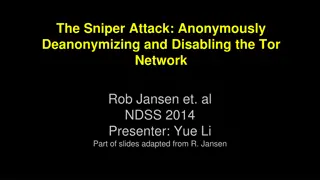Deanonymization of TOR HTTP Hidden Services - Techniques and Defense
This detailed content delves into the deanonymization of TOR HTTP hidden services, discussing known techniques, downgrading the protocol, and potential fixes. It covers the concept of hidden services, key certificate risks, search methods, and Gzip compression vulnerabilities. The author, a security researcher and former bug bounty hunter, shares insights on how to navigate the dark net securely.
Download Presentation

Please find below an Image/Link to download the presentation.
The content on the website is provided AS IS for your information and personal use only. It may not be sold, licensed, or shared on other websites without obtaining consent from the author. Download presentation by click this link. If you encounter any issues during the download, it is possible that the publisher has removed the file from their server.
E N D
Presentation Transcript
Deanonymization of TOR HTTP Hidden Services Ionut Cernica
Table Of Contents Introduction Other techniques developed by me Known deanonymization techniques How to fix Downgrading the protocol Demo time and Closing Remarks
whoami Security Researcher Application Security Engineer Former Bug Bounty Hunter CTF Player Former PhD Student Entrepreneur
The Onion Router The Internet The Dark Net http://*.onion
Hidden Service Allow users to publish their service without revealing their identity Configuration HiddenServiceDir /var/lib/tor/hidden_service/ HiddenServicePort 80 127.0.0.1:80 Hidden service address mhphb7utr2eqmul5mgggk5apf6dyjlldgujfvxohjiqu5pd2b7scg6qd.onion
Known Deanonymization Techniques /server-status Gzip Key Certificate favicon.ico Search for the onion address Hack the server
Key Certificate TLS certificate might be indexed on the surface web and can lead to the same resource from the dark net or other services of the same actor Shodan indexes information from the internet including TLS information
Search for the onion address Very little chance of success Just search the onion address on search engines like Google, Bing, DuckDuckGo or Shodan
Gzip Compression Jose Carlos found that around 10% of the webservers leak the remote date when compressing HTTP Responses with gzip Its not a problem in TOR and its not a bug in the protocol as well and is not a problem with the GZIP It helps you get an idea of where one or another server is hosted.
favicon.ico matching favicon is that tiny icon that users see in the browser s URL bar It is possible to match favicons found on dark web with favicons on the internet using Shodan The Quantum ransomware group is an example: Using its favicon from the dark web, Talos found its equivalent on the surface web and could locate the threat actor s web server
Hack the server Find vulnerabilities in order to deanonymize the server Remote Command Execution Local File Inclusion Make a research on the server and look for other vulnerabilities that can leak the servers IP
Downgrading The HTTP Protocol How did I find this? - Strange requests in my access.log file using HTTP/1.0 protocol: "GET /NotFoundNotFoundNotFoundNotFoundNotFoundNotFou .. HTTP/1.0" 400 802 "-" "masscan - for more info go - http://something.org - Same behavior on my honeypots - The requests keep coming for days - I dumped the hole request - I replicated and got an internal virtual host of mine that I didn t want to be public - This was the moment when I realized the potential of this flaw, both on the internet and dark web - Started to develop an improved version of this /NoTFound . request in order to exfiltrate the IP or unknown domains
Downgrading The HTTP Protocol Why this behavior? - Is not because of a security problem in apache-based servers like: apache2, nginx or tomcat - Is all about configuration - The server must choose one of the domains to forward the request - The client doesn t supply a Host: example.com header and to do that we can choose the first version of HTTP protocol -> HTTP/1.0 - The server will choose the first virtualhost - In the response we can find first declared virtualhost. Which might be a domain or an IP or just localhost
The leak The leak is in the: - Triggered exceptions - Doesn t work on all apache-based servers - HTTP/1.0 400 Bad Request - HTTP/1.0 403 Forbidden - Even the 404 NotFound sometimes discloses the IP - Server redirects - The best way to leak the IP - works in servers like nginx, apache2, tomcat
HTTP/1.0 400 Bad Request The same result with a long URL or a file upload that exceeds the server limit
HTTP/1.0 403 Forbidden Very easy to trigger I used the ^.ht* rule and you can visit /.html to not attract attention The rule above is for .ht files, like .htacces or .htpasswd, etc
Server redirects The best way to trigger redirect is to search for directories that serves static files - servers based on apache must put a / at the end - Exampe: if we visit http://server.com/dir it will auto redirect to http://server.com/dir/ - most cases you can find on the first page directories - if there is an app without directories that serves something, then try some predefined directories that exists in some servers like /img , /css , /icons , /js - this directories are available only if you visit with the IP 127.0.0.1, which most of the time in TOR this is the IP that you access the application
Apply this on the Internet I didn t make a research on this. I suppose is at the limit of legality It appears that others did this before, but I don't know if they followed this problem I expect to exfiltrate domains that normally you cannot get from an IP. It's a kind of reverse DNS on a specific IP
Other techniques - ETag The ETag or entity tag is part of HTTP, the protocol for the World Wide Web Downgrade the protocol has nothing to do with this one It suppose to take the ETag of the default domain and search it on the internet We can find ETag in the response header This can be done if the first page is static and not dynamic We can use Shodan The chance of success is quite small, but it's worth a try
Other techniques - Same Network Technique This technique involves domain enumeration on a given host Because the number of known .onion address on TOR is small, then it is doable to search on the same server other TOR domains If we find multiple domains on a single server then is enough to find the IP address of one of the domains to find the others I remember I found a hosting provider on TOR for hidden services, but the owner didn t used a good sandbox and I was able to find the IP address. Then if I would make a domain enumeration on that server I would find the other hidden services hosted on that server To achieve that we need to change in Host: header the name of the hidden service with the ones from the list, one at a time and look for the response if is the same
Closing Remarks We saw how many possibilities are there to trigger an exception in order to leak an IP or a domain in a server. If you are luck enough, the IP can be 127.0.0.1 or a domain that doesn t specify something Also, how easy is to trigger a redirect in order to leak the IP Keep in mind to create a virtual host for localhost or 127.0.0.1 to be sure that all the traffic for http/1.0 will go through it Try not to reuse certificates from other projects Disable server-status page All of this are configuration problems and is important that any sysadmin to know about this
Thanks Do you have any questions? Ionut.cernica@gmail.com CREDITS: This presentation template was created by Slidesgo, including icons by Flaticon, infographics & images by Freepik
















































